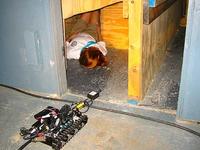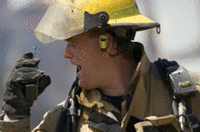-
Quake disrupts East Coast cell service

Tuesday’s 5.9 magnitude earthquake that struck Virginia and could be felt across the northeast, exposed continuing weaknesses in U.S. emergency communications networks; residents in the northeast experienced difficulty making calls on their cell phones, despite no reported damage to communications infrastructure
-
-
Water mist puts out fires at low pressure
A new water mist system allows for fires to be extinguished from a distance of eight meters; the system’s special nozzles generate a fine mist of tiny water droplets; the water and the propellant nitrogen are non-hazardous, environmentally friendly, and leave no residues
-
-
Antenna-equipped garments here
To make communications devices more reliable, researchers are working on incorporating radio antennas directly into clothing, using plastic film and metallic thread; the new antenna design has a range four times larger than that of a conventional antenna worn on the body — one that is used by American soldiers today
-
-
New tool helps visualize post-event disaster environments
Using iPad mobile devices, emergency preparedness officials and first responders participating last month in the FEMA’s National Level Exercise 2011 (NLE-11), were able, for the first time, to make use of a new, science-based software tool that allows them to view and modify accurate models of building damage and other post-event disaster effects
-
-
Innovative disaster communication tech developed

Communication networks typically collapse when they are needed most — during and in the immediate aftermath of massive disasters; researchers have developed a — an innovative wireless system called LifeNet designed to help first responders communicate after disasters; LifeNet is a mobile ad-hoc network designed for use in highly transient environments that requires no infrastructure such as Internet, cell towers or traditional landlines
-
-
Ensuring reliable wireless alarm beacons for first responders
Wireless emergency safety equipment could save lives — if signals are transmitted reliably; NIST is studying interference between Personal Alert Safety Systems (PASS) with wireless alarm capability, and radio-frequency identification (RFID) systems
-
-
New rescue robot can reach trapped miners, people under rubble
A new rescue robot can find dangers — poisonous gases, flooded tunnels, explosive vapors, and unstable walls and roofs — and provide relief to trapped miners or people buried under rubble; it is able to navigate through eighteen inches of water, crawl over boulders and rubble piles, and move in ahead of rescuers to evaluate precarious environments and help plan operations
-
-
Robots help evacuate buildings, search for trapped people

Two Georgia Tech engineers designed an emergency robot to help people evacuate buildings in an emergency; they say that emergency robots pacing the hallways and instructing people how to get to the emergency exits is a better solution than static emergency instructions placed on the wall; the robots will also search for injured or trapped people who failed to evacuate the building
-
-
Classrooms cut off from emergency alert systems
Classrooms were designed to be isolated cocoons that allow children to focus on learning away from distractions; while ideal for learning, these classrooms pose a significant problem for mass notification systems making it difficult for authorities to notify children, college students, and teachers during emergencies
-
-
Emergency alerts for cell phones
Residents living near Austin, Texas can now receive important emergency notifications on their cell phones for free; with more and more individuals switching to cell phones and abandoning their land lines, emergency responders and government officials have been forced to adapt emergency warning systems to connect to cell phones instead
-
-
Napolitano addresses Public Private Partnership conference
DHS secretary Janet Napolitano spoke to the attendees and reiterated the private sector’s role as an important partner in strengthening the homeland security enterprise better to defend against evolving threats, including disasters
-
-
Thales’s Liberty LMR completes Department of Interior tests

Thales’s Liberty LMR has passed U.S. Department of Interior tests; the radio had earlier been approved for Law Enforcement and Tiers 1, 2, and 3; the company says the Liberty LMR, a software-defined radio solution, enables interoperability across all public safety bands, linking government agencies and first responders with a single portable radio
-
-
Alliance urges Congress to focus on D block allocation
The Public Safety Alliance (PSA) strongly encourages Congress to stay focused on legislation that would allocate the D Block to public safety for the creation of a nationwide, interoperable first responder broadband network
-
-
New risk to first responders: chemical suicide
First responders and HAZMAT teams are becoming aware of a new threat: chemical suicide. This new type of suicide is increasing in popularity as a result of instructions being posted on the Internet; the suicide is carried out by mixing household cleaners and detergents to produce a cloud of toxic gas; trouble is, after killing its intended victim, the cloud of gas remains present, threatening to kill those who attempt a rescue
-
-
Wisconsin hospitals ahead of the curve
In the 2009 H1N1 flu epidemic while public health officials across the United States were contending with shortages of basic supplies like ventilator masks, Wisconsin health authorities were able smoothly to weather the storm thanks to its stockpiles of protective clothing, emergency planning, and advanced training
-
More headlines
The long view
The Surprising Reasons Floods and Other Disasters Are Deadlier at Night
It’s not just that it’s dark and people are asleep. Urban sprawl, confirmation bias, and other factors can play a role.
Why Flash Flood Warnings Will Continue to Go Unheeded
Experts say local education and community support are key to conveying risk.
